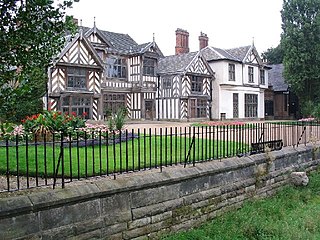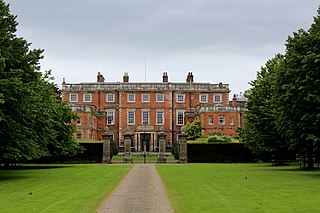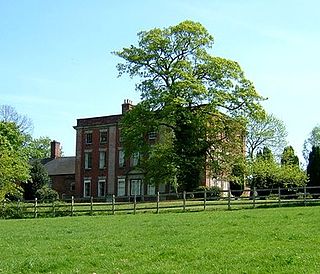
Bretton Hall is a country house in West Bretton near Wakefield, West Yorkshire, England. It housed Bretton Hall College from 1949 until 2001 and was a campus of the University of Leeds (2001–2007). It is a Grade II* listed building.

Wythenshawe Hall is a 16th-century timber-framed historic house and former manor house in Wythenshawe, Manchester, England, five miles (8 km) south of Manchester city centre in Wythenshawe Park. Built for Robert Tatton, it was home to the Tatton family for almost 400 years. Its basic plan is a central hall with two projecting wings.

Castle Cary is a market town and civil parish in south Somerset, England, 5 miles (8 km) north west of Wincanton and 8 miles (12.9 km) south of Shepton Mallet, at the foot of Lodge Hill and on the River Cary, a tributary of the Parrett.

Sockburn is a village and former civil parish, now in the parish of Neasham, in the Darlington district, in the ceremonial county of Durham, England. It is situated at the apex of a meander of the River Tees, to the south of Darlington, known locally as the Sockburn Peninsula. Today, all that remains of the village is an early nineteenth-century mansion, a ruined church and a farmhouse built in the late eighteenth century.

New Hall Manor is a medieval manor house, now used as a hotel, in Sutton Coldfield, West Midlands, England.

Wallington is a country house and gardens located about 12 miles (19 km) west of Morpeth, Northumberland, England, near the village of Cambo. It has been owned by the National Trust since 1942, after it was donated complete with the estate and farms by Sir Charles Philips Trevelyan, the first donation of its kind. It is a Grade I listed building. Some of the wealth of the Trevelyan family derived from the holding of slaves in Grenada.

Mells is a village and civil parish in Somerset, England, near the town of Frome.

Sulgrave Manor, Sulgrave, Northamptonshire, England is a mid-16th century Tudor hall house built by Lawrence Washington, the 3rd great-grandfather of George Washington, first President of the United States. The manor passed out of the hands of the Washington family in the 17th century and by the 19th had descended to the status of a farmhouse. In 1911, Theodore Roosevelt, a former US president, suggested a memorial to commemorate 100 years of peace between the United Kingdom and the United States, and the manor was bought for this purpose in 1914. Between 1920 and 1930 the manor was restored, and a garden was created by Reginald Blomfield. Sulgrave Manor is now administered by a trust and is a Grade I listed building.

Annesley Hall is a Grade II listed country house near Annesley in Nottinghamshire, England and the ancestral home of the Chaworth-Musters family. The 13th-century park, 17th-century terraces and 19th-century pleasure gardens and walled gardens of the hall are Grade II* listed on the Register of Historic Parks and Gardens.

Newby Hall is a country house beside the River Ure in the parish of Skelton-on-Ure in North Yorkshire, England. It is 3 miles (4.8 km) south-east of Ripon and 6 miles (9.7 km) south of Topcliffe Castle, by which the manor of Newby was originally held. A Grade I listed building, the hall contains a collection of furniture and paintings and is surrounded by extensive gardens. Newby Hall is open to the public.

Garendon Hall was a country home near Shepshed, Leicestershire, England. It was demolished in 1964.

The Old Hall Hotel is a public house and restaurant in High Street, Sandbach, Cheshire, England. It was built in 1656 on the site of a previous manor house, and since been extended. In the 18th century it was used as a coaching inn and hotel. It closed as a hotel in 2005; it was unused for four years, and its fabric suffered serious deterioration. In 2010 the building was bought by Brunning and Price, a subsidiary of the Restaurant Group, who repaired and restored it. It was reopened as a public house and restaurant in 2011. The building is timber-framed, and is recorded in the National Heritage List for England as a designated Grade I listed building.

Ince Manor or Ince Grange is a former monastic grange in the village of Ince in Cheshire, England. The remains of the manor house, consisting of the old hall and the monastery cottages, are recorded in the National Heritage List for England as a designated Grade I listed building, and a scheduled monument It is one of only two surviving monastic manorial buildings in Cheshire, the other being Saighton Grange Gatehouse.

Matfen Hall is a 19th-century country mansion in Matfen, Northumberland, England, the seat of the Blackett baronets and now also a hotel and country golf club. It is a Grade II* listed building.

Walton Hall is an 18th-century country house situated in the village of Walton on Trent, Derbyshire. It is a Grade II* listed building but is in slow decay and is officially registered on the Buildings At Risk Register.

Cothelstone Manor in Cothelstone, Somerset, England was built in the mid-16th century, largely demolished by the parliamentary troops in 1646 and rebuilt by E.J. Esdaile in 1855–56.

Fore Street in Chard, Somerset, England was built in the late 16th and early 17th century, following a fire which destroyed much of the town in 1577.

Hangleton Manor Inn, the adjoining Old Manor House and associated buildings form a bar and restaurant complex in Hangleton, an ancient village which is part of the English city of Brighton and Hove. The manor house is the oldest secular building in the Hove part of the city; some 15th-century features remain, and there has been little change since the High Sheriff of Sussex rebuilt it in the mid-16th century. Local folklore asserts that a 17th-century dovecote in the grounds has been haunted since a monk placed a curse on it. The buildings that comprise the inn were acquired by Hangleton Manor Ltd in 1968, and converted to an inn under the Whitbread banner. The brewery company Hall & Woodhouse have owned and operated it since 2005. English Heritage has listed the complex at Grade II* for its architectural and historical importance, and the dovecote is listed separately at Grade II.

Langton by Spilsby, sometimes called Langton by Partney, is a village and civil parish in the East Lindsey district of Lincolnshire, England. It is situated approximately 4 miles (6 km) north from the town of Spilsby, Lincolnshire. The civil parish includes the hamlet of Sutterby. From the 2011 census the population is included in the civil parish of Sausthorpe.
Astley is a settlement in the Metropolitan Borough of Wigan in Greater Manchester, England. Originally a village, it now forms a continuous urban area with Tyldesley to the north. It lies on flat land north of Chat Moss and is crossed by the Bridgewater Canal and the A580 "East Lancashire Road". Astley contains several listed buildings designated by English Heritage and included in the National Heritage List for England. Most are listed at Grade II, the lowest of the three gradings given to listed buildings and is applied to "buildings of national importance and special interest".




















